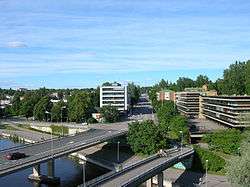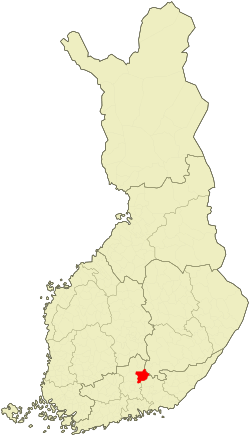Heinola
Heinola is a town and a municipality of 18,878 inhabitants (31 January 2019)[2] located in the region of Päijänne Tavastia, Finland. Neighbour municipalities: Asikkala, Hartola, Iitti, Kouvola, Mäntyharju, Nastola, Pertunmaa and Sysmä.
Heinola | |
|---|---|
Town | |
| Heinolan kaupunki Heinola stad | |
 A view from Heinola railway bridge towards the town center | |
 Coat of arms | |
 Location of Heinola in Finland | |
| Coordinates: 61°12′N 026°02′E | |
| Country | |
| Region | Päijänne Tavastia |
| Sub-region | Heinola sub-region |
| Charter | 1776 |
| City rights | 1839 |
| Government | |
| • Town manager | Jari Parkkonen |
| Area (2018-01-01)[1] | |
| • Total | 839.28 km2 (324.05 sq mi) |
| • Land | 676.33 km2 (261.13 sq mi) |
| • Water | 162.96 km2 (62.92 sq mi) |
| Area rank | 125th largest in Finland |
| Population (2019-01-31)[2] | |
| • Total | 18,878 |
| • Rank | 57th largest in Finland |
| • Density | 27.91/km2 (72.3/sq mi) |
| Population by native language | |
| • Finnish | 98% (official) |
| • Swedish | 0.2% |
| • Others | 1.8% |
| Population by age | |
| • 0 to 14 | 14.4% |
| • 15 to 64 | 63.7% |
| • 65 or older | 21.9% |
| Time zone | UTC+02:00 (EET) |
| • Summer (DST) | UTC+03:00 (EEST) |
| Municipal tax rate[5] | 20.5% |
| Climate | Dfc |
| Website | www.heinola.fi |
Heinola is perhaps best known for its summer activities such as the Sauna-sitting World Championships, and for being the cradle of rheumasurgery.
History
Heinola used to be a remote village of then larger Hollola until it gained significance in 1776 when Gustav III of Sweden promoted it to be the governmental center of the province in which it was then located. The grid plan of the city center is from that era. Heinola also became a center of commerce for nearby regions.[6]
When Finland became a part of Russia in 1809, the capital of the province was moved eastwards with the state border. To compensate this, Heinola gained a city status in 1839. Before World War II, Heinola was widely known as a spa town, and until 1972 it served as a location for an institute (seminaari) that taught elementary school teachers. These both were established in the 1890s and played an important role in the town life.[6]
Heinolan maalaiskunta was merged into Heinola in 1997.
Economy
After World War II Heinola has been economically an industrial town, mainly due to its wood processing industry. Industry remained the largest source of employment until the 1970s, when the trade and services sector grew larger, following a national trend.
Heinola has been hit hard by Late-2000s recession. UPM-Kymmene, that used to be the largest employer after the public sector, reported closing down its sawmill and plywood mill in Heinola during 2010.[7]
Sights
The bird zoo is located just next to the bus station. The founding idea of the bird zoo is to offer help for birds that have injured themselves in the traffic, power lines and glass surfaces, and to rehabilitate them back to the nature. The birds that remain in the care, and the ones that are not capable of returning to the nature, but are considered to maintain a meaningful life in capture, are available for spectators to see. For school groups and tourists, this can be a good opportunity to identify some of the species that are not so easily spotted in the wild. In the summer, tropical birds that spend the winter inside are also to be seen.[8]
Geography
Heinola is largely situated between two lakes, Ruotsalainen and Konnivesi. A waterway connecting the lakes crosses the town and is, along with an esker also crossing the town, a characterising geographical feature of Heinola. A motorway (Finnish national road 4/E75) connects Heinola to Lahti (distance 35 km or 22 mi) and Helsinki (distance 138 km or 86 mi); it also acrosses Lake Ruotsalainen on the Tähtiniemi Bridge in the northern part of town. Heinola is also southern head of the Finnish national road 5, which goes over 900 kilometres to the north through the cities Kuopio and Kajaani to Sodankylä.
International relations
Twin towns — sister cities
Heinola is twinned with:[9]



See also
References
- "Area of Finnish Municipalities 1.1.2018" (PDF). National Land Survey of Finland. Retrieved 30 January 2018.
- "Suomen virallinen tilasto (SVT): Väestön ennakkotilasto [verkkojulkaisu]. Tammikuu 2019" (in Finnish). Statistics Finland. Retrieved 15 March 2019.
- "Population according to language and the number of foreigners and land area km2 by area as of 31 December 2008". Statistics Finland's PX-Web databases. Statistics Finland. Retrieved 29 March 2009.
- "Population according to age and gender by area as of 31 December 2008". Statistics Finland's PX-Web databases. Statistics Finland. Retrieved 28 April 2009.
- "List of municipal and parish tax rates in 2011". Tax Administration of Finland. 29 November 2010. Retrieved 13 March 2011.
- "The history of Heinola". Heinolan kaupunki. Retrieved 13 February 2010.
- "UPM job losses total 830". YLE. 12 January 2010. Retrieved 13 February 2010.
- . Heinolan kaupunki http://www.heinola.fi/FIN/Palvelut/Matkailu/Lintutarhat/tietoa_lintutarhasta.htm. Retrieved 21 February 2014. Missing or empty
|title=(help) - "Ystävyyskaupungit". heinola.fi (in Finnish). Heinola. Retrieved 2019-12-07.
External links
![]()
- Town of Heinola – official website, finnish, swedish, english and russian

